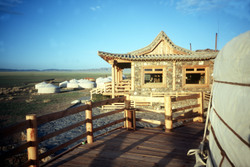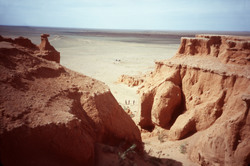We first saw Mongolia from a plane belonging to the national airline, MIAT. Missing In Action Transportation, one passenger called it, perhaps referring to the fact that there were only four aircraft in the fleet. Amusing, but not quite fair. The Airbus 310 was well-maintained and its cabin crew was bright and efficient. Not bad for a former communist country of 2 1/2 million people.
Below us the ancestral home of the Mongol armies that had nearly conquered Europe in the 13th century ran unbroken to the horizon. The Gobi Desert, since Gobi means desert in Mongolian, is like saying the Desert Desert.
Gradually the Gobi rose into dun-colored hills. Among them appeared a sprawling city of white houses, Soviet-style apartment blocks and round, windowless tents: Ulaanbaatar, Mongolia's capital city.
Dinner took place in one of the tents, in the West known as yurts, or gers in Mongolia. Originally covered with skins, they are packed up and moved with their nomadic owners. But the Abai-Sain Khan Palace Restaurant was no simple family ger. It seated over 100 diners, many of them musicians and singers who had come to perform in a festival of traditional music. After dinner, one, a "throat" singer, sang the strangest song we'd ever heard. The man produced two sounds at once, a deep-toned growl under a piercing, high melody. Neither was the least bit human.
There were seven Americans in the restaurant, gathered to participate in Nomadic Expeditions' Journey to Mongolia tour. Our leader's name was Bayanna, an enthusiastic woman fluent in Russian and English. She was the first of several remarkable Mongolians we were to meet in the days to come.
"I was born and raised in the city," she said when we asked about the nomads' lives. "I spend vacations with a nomadic family that has 300 sheep. If they let me guard them, I'd lose them all. Their 4-year-old son can identify every one." When we flew to the Gobi, Bayanna came with us.
From tiny Dalanzadgad Airport, rugged Land Rovers drove us over a dirt track through a desolate, thrilling landscape. Sheep and twin-humped camels grazed on the scrub-tufted desert, with ochre mountains on the left and a mirage on the right. The driver pointed it out, a thin river that looked absolutely real. Except that it wasn't.
Eventually we saw another mirage, except that this one was real. It was Three Camel Lodge, a building of stone and upturned roofs flanked by neat, white gers. Inside each was a large room with circular walls padded with felt. To the left and right stood brightly patterned beds, a table, a chest and a wood-burning stove. Very unusual and very nice.
The next morning, a man who looked more like a Mongolian wrestler than the paleontologist he was drove us to the red sandstone buttes and gorges of the Flaming Cliffs, one of the richest fossil sites on earth. There he led us to a group of scattered bones he'd recently found poking out of the sand. "Protocerotops," he said. "Seventy million years old."
"I told you," Bayanna said, "that each part of Mongolia is beautiful in its own right."
We returned to the city and made our way to the Hustein National Park, created specifically to reintroduce the last remaining species of wild horses into their native land. We spotted them in a ravine, 10 sturdy animals with large heads and thick necks. Skittish around humans, the horses moved off except for two that remained, unafraid. Then we noticed a small, white lump on the ground with - suddenly - a black swishing tail. It tottered up on spindly legs and, like an obedient son, followed its mother away.
In the mountainous pine forest of the Begd Khan Reserve lie the ruins of the Manzushir Monastery. Like hundreds of other Buddhist temples in Mongolia, it was the victim of the communist purges of the 1930s, its lamas executed as enemies of the state.
With another guide, Soyolmaa, we picnicked overlooking the wrecked stone walls and the new monastery built next to them. In it, along with Buddhist altars and statues and wonderful wooden masks, were black-and-white photos of the way the complex had been.
"In the '30s," Soyolmaa said, nodding at the driver, "you and I would have been whispering so that he couldn't spy on us." Today, with so little remaining, the monastery is probably a more peaceful place. But then it was alive.
Of all the highlights of the trip, my favorite was the day when we woke to a clear, blue sky and air like crystal. A little night rain had turned the desert green, with sprinkles of purple iris. As we drove, the wind became wilder and the road plunged into a series of dirt-brown upheavals of rock. When we emerged we saw in the distance a 65-mile-long band of pure white sand striping the Altai Mountains. In a dusty yard, a nomad helped us into the saddles of his kneeling camels, prodded them up and led us toward the dunes.
This was the true Hollywood desert, the, the sand-in-your-eyes, "Lawrance of Arabia" desert. So we pulled our cowboy bandannas over our noses and rolled between the camel's shaggy humps to the highest sand dunes we'd ever seen.
Up we clambered for stupendous views of the Gobi from the sensuous mountains of sand while we gritted our teeth against the swirling wind. Except for one who donned a pair of swimming goggles and a blue paper mask. He may have looked like an amphibian from outer space, but he had no sand in his mouth.
Guess who.
IF YOU GO
Nomadic Expeditions (800-998-6634, www.nomadicexpeditions.com) offers tours in Mongolia, China, Tibet, Bhutan and Siberia. Customized expeditions are also available.
MIAT (800-642-8768, www.miat.com) flies nonstop to Ulaanbaatar from Tokyo, Seoul, Beijing, Moscow and Berlin.
© Copley News Service




